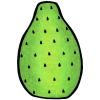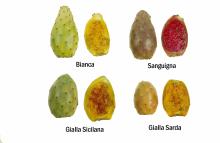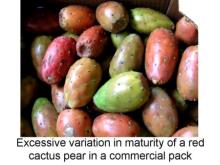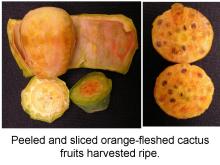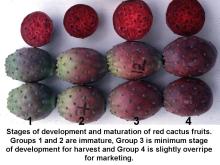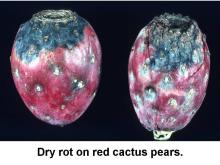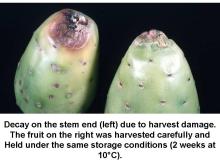Maturity and Quality
Fruit size and fullness, external color changes from green to yellow or red, abscission of the glochids (tufts of very small spines), fruit firmness, and flattening of the floral cavity.
Cactus pears should be picked when fully-ripe to assure good flavor quality.
- Uniformity and intensity of the characteristic color of each cultivar (pale-green, yellow, orange, red, or purple)
- Size
- Freedom from defects and decay.
- There are large differences among cultivars in total soluble solids (12-17%), titratable acidity (0.03-0.12%), pH (6.0-6.6), and ascorbic acid contents (20-40 mg/100g fresh weight)
Postharvest Handling and Storage
6-8°C (43-46°F)
Storage potential is 2-5 weeks; depending on cultivar, ripeness stage, and harvest season.
Cactus pear is a non-climacteric fruit with a relatively low respiration rate [15-20 ml CO2/kg·hr at 20°C (68°F)].
To calculate heat production multiply ml CO2/kg·hr by 440 to get Btu/ton/day or by 122 to get cal/metric ton/day.
No published information but since cactus pears are picked fully-ripe it is likely that they are not affected by postharvest exposure to ethylene.
90 to 95%
Packaging in perforated plastic bags or box liner is effective in reducing water loss under lower relative humidities.
Less than 0.3 µl/kg·hr at 20°C (68°F)
Limited research (in Italy) indicates that storage of cactus pears at 5°C (41°F) in 2% O2 + 2-5% CO2 delays ripening and extends storage-life (based on appearance quality) to 4-8 weeks (compared to 2-4 weeks in air storage).
Disorders
Chilling Injury. Exposure to temperatures below 5°C (41°F) for longer than a few days causes chilling injury, as indicated by pitting and dark-brown spots on the peel surface and increased susceptibility to decay. Conditioning at 38°C (101°F) for 24 hours reduces incidence and severity of chilling injury during subsequent handling at temperatures below 5°C (41°F).
Physical damage to the peel and stem-end during harvesting and handling and/or chilling injury predispose cactus pears to attack by decay-causing pathogens, including Penicillium spp., Alternaria spp., and Dothiorella ribis. Curing [1-2 days at 20°C (68°F)] to encourage wound healing and/or prestorage dipping in water at 55°C (129°F) for 5 minutes can reduce decay incidence and severity during subsequent storage.



